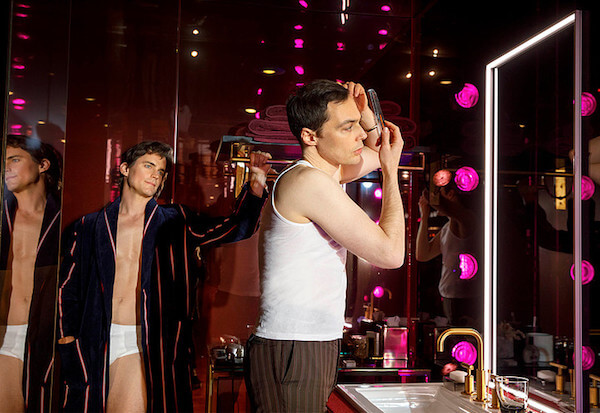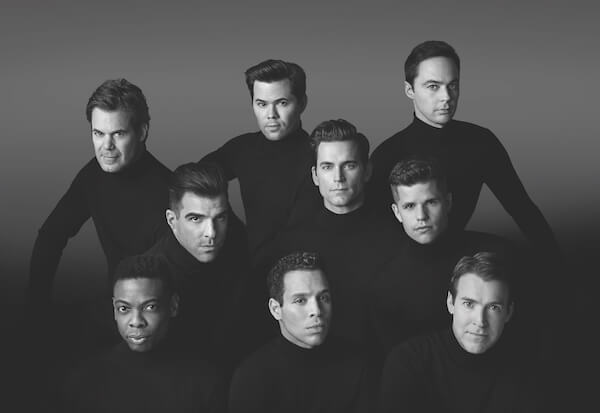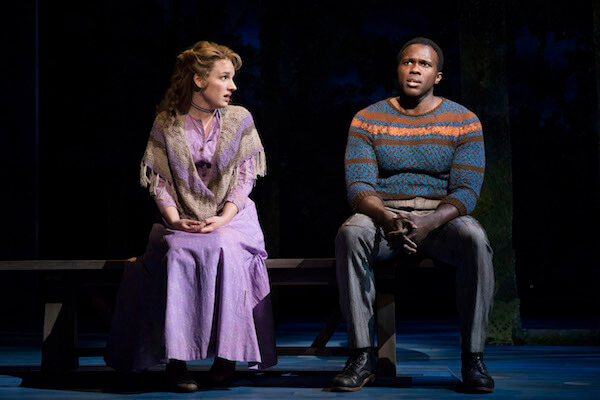Rachel Tucker, Michael Esper, and Aaron Lazar in “The Last Ship.” | MATTHEW MURPHY
Let’s address the 400-ton boat in the living room first, shall we? The book of the new musical by John Logan and Brian Yorkey, “The Last Ship,” is not great. You could sail a tanker through the holes in its logic. The story is part “Billy Elliot Builds a Boat” and part “Kinky Boats,” but there’s an inexhaustible catalog of musicals that have kept afloat even with an inept book. And “The Last Ship” is a good musical, bordering at times on brilliant.
The music by Sting beautifully reflects the many inspirations that have shaped his career. From haunting harmonics to chilling overtones to an in-depth understanding of what makes a good song in a musical, this score is exquisite on so many levels. It’s what makes the show work, and if you can abide the story’s problems you’ll be richly rewarded.
All you really need to know about the plot is that it concerns out-of-work shipbuilders, has a complicated love triangle, and explores the quest for meaning in life. The book’s difficulties notwithstanding, director Joe Mantello manages to create a stirring evening, and Steven Hoggett’s choreography makes use of the stomping and earthy energy that was so successful for him in “Once.” There are times when the choreography is breathtaking.
Two nautically inspired musicals take to Broadway’s challenging seas
As Gideon, the boy who comes home after 15 years with hopes of wooing his old girlfriend Meg, Michael Esper has never sounded better. He capitalizes on a roughness in his voice to wonderful effect and conveys a depth of emotion that creates empathy for his choices and his regrets. Rachel Tucker as Meg is splendid, with a clear voice and straight, powerful singing that goes to the center of every song. Aaron Lazar is in his element as Arthur, the more conventional man chosen by Meg. His is the most lyrical role to sing, and Lazar handles it impeccably.
In fact, all the singing is outstanding. Under Robert Mathes’ supervision, the singing and orchestrations do as much to convey the story as any other single element. David Zinn’s sets and costumes are appropriately industrial and striking.
All of this works so well together that even though the story’s conflicts and ending are predictable, you’re left with a lump in your throat. As with David Byrne’s “Here Lies Love” — still the most exciting show in town — when masters of pop music apply themselves to Broadway, the result can be unexpectedly exciting, moving, and new.
Jay Armstrong Johnson, Tony Yazbeck, and Clyde Alves in “On the Town.” | JOAN MARCUS
New York City has always enjoyed a special place in the global imagination — symbolizing freedom, opportunity, the chance to reinvent oneself, and, of course, adventure in countless books, movies, plays, and musicals. With the exception of “Annie,” no show has reveled in the romanticized city more than the 1944 classic “On the Town,” now being revived at the Lyric Theatre.
The story of three sailors on 24-hour shore leave who want to see the sights and fall in love is classic feel-good Americana. Like so much popular entertainment produced from the Depression through World War II, it was created as pure escapism in a bleak time.
Fueled by a silly and often funny book by Betty Comden and Adolph Green and Leonard Bernstein’s groundbreaking and magnificent score, the show is the very definition of an “old-fashioned musical.” It plays it safe down to the sexual innuendo, and while that makes it great family entertainment, it does have a museum quality that ultimately blunts the production.
On the positive side, the score has seldom sounded better and the large orchestra gives it full voice. Joshua Bergasse’s choreography, while heavily indebted to Jerome Robbins with a clever bit of Balanchine thrown in, is often exciting and fresh, an essential for such a dance-heavy show.
Where the production misses is in the direction and the casting. Even for an inherently broad show, director John Rando misses the opportunity to elicit any kind of subtlety from the characters. It’s all primary colors, which can be amusing but tends to wear thin.
Tony Yazbeck as Gabey sings decently and dances very well, but he plays the role as a one-note galoot. If you have never seen Jackie Hoffman before, you may be enchanted by her oversize, vaudeville performance as Madame Dilly, but for those who know her work it is shaped largely by her trademark shtick-heavy mugging. Both Jay Armstrong Johnson as Chip and Clyde Alves as Ozzie find some depth to their roles, but Alysha Umphress as Hildy isn’t really up to the vocal demands of the role, at least based on the performance I saw.
Elizabeth Stanley as Claire De Loone is easily the best in the show, finding a way to balance the broad comedy with heart that makes her both hilarious and compelling.
Visually, the show is terrific. Beowulf Boritt’s sets and projections use technology very well, and Jess Goldstein’s costumes capture the period perfectly and move really well in the dancing.
You won’t have a bad time at this show. It is, after all, an American classic that can survive a production’s shortcomings. Still, I wish they hadn’t played it all so safe, particularly while celebrating a city that gets its reputation for never doing that.
THE LAST SHIP | Neil Simon Theatre, 250 W. 52nd St. | Tue., Thu. at 7 p.m.; Wed., Fri.-Sat. at 8 p.m.; Wed., Sat. at 2 p.m.; Sun. at 3 p.m. | $63.75-$141.75 at ticketmaster.com or 800-754-3000 | Two hrs., 30 mins., with intermission
ON THE TOWN | Lyric Theatre, 213 W. 42nd St. | Tue., Thu. at 7 p.m.; Wed., Fri.-Sat. at 8 p.m.; Wed., Sat. at 2 p.m.; Sun. at 3 p.m. | $46.25-$147.50 at ticketmaster.com or 800-754-3000 | Two hrs., 30 mins., with intermission






































